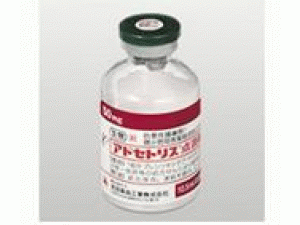本妥昔单抗重组注射剂(Adcetris Injection 50mg)
 产地国家:日本
处方药:是
所属类别: 50毫克/瓶
包装规格: 50毫克/瓶
计价单位:瓶
生产厂家英文名:Takeda
原产地英文商品名:ADCetris(アドセトリス点滴静注用)50MG/VIAL
原产地英文药品名:Brentuximab Vedotin(Genetical Recombination)
中文参考商品译名:ADCetris(アドセトリス点滴静注用)50毫克/瓶
中文参考药品译名:本妥昔单抗重组
产地国家:日本
处方药:是
所属类别: 50毫克/瓶
包装规格: 50毫克/瓶
计价单位:瓶
生产厂家英文名:Takeda
原产地英文商品名:ADCetris(アドセトリス点滴静注用)50MG/VIAL
原产地英文药品名:Brentuximab Vedotin(Genetical Recombination)
中文参考商品译名:ADCetris(アドセトリス点滴静注用)50毫克/瓶
中文参考药品译名:本妥昔单抗重组
简介
2014年1月18日,新型抗癌点滴静注剂brentuximab vedotin(商标名 Adcetris,アドセトリス点滴静注用)获日本批准上市,用于2种适应症: (1)复发性或难治性CD30阳性霍奇金淋巴瘤(HL)成人患者; (2)复发性或难治性CD30阳性系统性间变性大细胞淋巴瘤(sALCL)成人患者。 Adcetris是一种抗体偶联药物(ADC),由靶向CD30蛋白的一种单克隆抗体、以及一种微管破坏剂(单甲基auristatin E,MMAE),通过一种蛋白酶敏感的交联剂偶联而成,该偶联技术为西雅图遗传学公司(Seattle Genetics)的专有技术。CD30蛋白是经典HL及sALCL的明确标志物,而Auristatin E可通过抑制微管蛋白的聚合作用阻碍细胞分裂。 Adcetris在血液中可稳定存在,在被CD30阳性肿瘤细胞内化后,可释放出MMAE。アドセトリス点滴静注用50mg 药用类别名称:抗肿瘤药物/微管抑制剂结合 anti-CD30 单克隆抗体 批准日期:2014年4月 商标名:ADCetris 一般名称:Brentskisimab Vedotin (基因改造)(brentuximab Vedotin (遗传学重组)) 本质Brentskisimab Vedotin (分子量: 约 153000) 是一种抗体药物复合物, 基因修饰单克隆抗体。抗体基团, 嵌合体单克隆抗体 (CAC10), 由可变部分的固定部分和人 igg1 的鼠抗人 cd30 抗体在中国仓鼠卵巢细胞中产生。 蛋白质基团是由 L 链 (κ链) 2 分子组成的糖蛋白, 由 H 链 (γ1链) 2 个分子和218个氨基酸残留物组成, 由447个氨基酸残留物构成。结构公式审批标准由于日本的临床试验病例极其有限, 在生产和销售后, 积累了一定数量的病例数据, 并通过对所有病例进行使用结果调查, 掌握了使用该制剂的患者的背景信息。 在早期收集有关该制剂的安全性和有效性的数据, 并采取必要措施适当使用该制剂。 药用药理学: 1. 作用机制Brentskisimab Vedotin是一种抗体药物复合体(ADC), 通过链接器被切断与蛋白酶mmae和anti-CD30IGG1嵌合体抗体具有细胞毒性活动。肿瘤生长抑制作用的药剂, 首先ADC绑定到CD30表达细胞, 后被纳入细胞作为一个adc-cd30复合体, 表达的 Mmae 是解放的蛋白水解反应。通过游离 Mmae 与管磷结合, 诱导了细胞周期的抑制、停止和凋亡。 2. 抗肿瘤作用(1) 体外试验该剂抑制卡帕斯299细胞系的增殖, Cd30-positive霍奇金淋巴瘤衍生的l540cy细胞系和Cd30-positive未分化的大细胞淋巴瘤。(2) 体内试验该剂抑制cd30-positive霍奇金淋巴瘤衍生l428细胞系和l540cy细胞系的肿瘤增殖, 或在异种移植小鼠中卡帕斯299细胞系移植, 也卡帕斯 299细胞线被延长, 以生存的小鼠注入静脉。 适应症:复发或难治性 cd30 阳性的以下疾病:霍奇金淋巴瘤未分化大细胞淋巴瘤 用法与用量:通常情况下,成年人每三周 Brentskisimab 1.8毫克/千克 (体重) 的输液。 另外, 要根据病人的病情适当用药。 包装规格:静脉输液50mg,1瓶 存储方法:避免冻结和保存从2到8℃。英文版说明书
ADCETRIS(Brentuximab Vedotin)ADCETRIS (brentuximab vedotin) U.S. Select Important Safety InformationBOXED WARNING: PROGRESSIVE MULTIFOCAL LEUKOENCEPHALOPATHY (PML)JC virus infection resulting in PML and death can occur in ADCETRIS-treated patients.ContraindicationADCETRIS concomitant with bleomycin due to pulmonary toxicity (e.g., interstitial infiltration and/or inflammation).Warnings and Precautions•Peripheral neuropathy (PN): ADCETRIS causes PN that is predominantly sensory. Cases of motor PN have also been reported. ADCETRIS-induced PN is cumulative. Monitor for symptoms such as hypoesthesia, hyperesthesia, paresthesia, discomfort, a burning sensation, neuropathic pain, or weakness. Institute dose modifications accordingly.•Anaphylaxis and infusion reactions: Infusion-related reactions (IRR), including anaphylaxis, have occurred with ADCETRIS. Monitor patients during infusion. If an IRR occurs, interrupt the infusion and institute appropriate medical management. If anaphylaxis occurs, immediately and permanently discontinue the infusion and administer appropriate medical therapy. Premedicate patients with a prior IRR before subsequent infusions. Premedication may include acetaminophen, an antihistamine, and a corticosteroid.•Hematologic toxicities: Fatal and serious cases of febrile neutropenia have been reported with ADCETRIS. Prolonged (≥1 week) severe neutropenia and Grade 3 or 4 thrombocytopenia or anemia can occur with ADCETRIS. Administer G-CSF primary prophylaxis starting with Cycle 1 for previously untreated patients who receive ADCETRIS in combination with chemotherapy for Stage III or IV HL. Monitor complete blood counts prior to each ADCETRIS dose. Consider more frequent monitoring for patients with Grade 3 or 4 neutropenia. Monitor patients for fever. If Grade 3 or 4 neutropenia develops, consider dose delays, reductions, discontinuation, or G-CSF prophylaxis with subsequent doses.•Serious infections and opportunistic infections: Infections such as pneumonia, bacteremia, and sepsis or septic shock (including fatal outcomes) have been reported in ADCETRIS-treated patients. Closely monitor patients during treatment for bacterial, fungal, or viral infections.•Tumor lysis syndrome: Closely monitor patients with rapidly proliferating tumor and high tumor burden.•Increased toxicity in the presence of severe renal impairment: The frequency of ≥Grade 3 adverse reactions and deaths was greater in patients with severe renal impairment compared to patients with normal renal function. Avoid use in patients with severe renal impairment.•Increased toxicity in the presence of moderate or severe hepatic impairment: The frequency of ≥Grade 3 adverse reactions and deaths was greater in patients with moderate or severe hepatic impairment compared to patients with normal hepatic function. Avoid use in patients with moderate or severe hepatic impairment.•Hepatotoxicity: Fatal and serious cases have occurred in ADCETRIS-treated patients. Cases were consistent with hepatocellular injury, including elevations of transaminases and/or bilirubin, and occurred after the first ADCETRIS dose or rechallenge. Preexisting liver disease, elevated baseline liver enzymes, and concomitant medications may increase the risk. Monitor liver enzymes and bilirubin. Patients with new, worsening, or recurrent hepatotoxicity may require a delay, change in dose, or discontinuation of ADCETRIS.•PML: Fatal cases of JC virus infection resulting in PML and death have been reported in ADCETRIS-treated patients. First onset of symptoms occurred at various times from initiation of ADCETRIS therapy, with some cases occurring within 3 months of initial exposure. Other possible contributory factors other than ADCETRIS include prior therapies and underlying disease that may cause immunosuppression. Consider PML diagnosis in patients with new-onset signs and symptoms of central nervous system abnormalities. Hold ADCETRIS if PML is suspected and discontinue ADCETRIS if PML is confirmed.•Pulmonary toxicity: Fatal and serious events of noninfectious pulmonary toxicity including pneumonitis, interstitial lung disease, and acute respiratory distress syndrome have been reported. Monitor patients for signs and symptoms, including cough and dyspnea. In the event of new or worsening pulmonary symptoms, hold ADCETRIS dosing during eva luation and until symptomatic improvement.•Serious dermatologic reactions: Fatal and serious cases of Stevens-Johnson syndrome (SJS) and toxic epidermal necrolysis (TEN) have been reported with ADCETRIS. If SJS or TEN occurs, discontinue ADCETRIS and administer appropriate medical therapy.•Gastrointestinal (GI) complications: Fatal and serious cases of acute pancreatitis have been reported. Other fatal and serious GI complications include perforation, hemorrhage, erosion, ulcer, intestinal obstruction, enterocolitis, neutropenic colitis, and ileus. Lymphoma with preexisting GI involvement may increase the risk of perforation. In the event of new or worsening GI symptoms, perform a prompt diagnostic eva luation and treat appropriately.•Embryo-fetal toxicity: Based on the mechanism of action and animal studies, ADCETRIS can cause fetal harm. Advise females of reproductive potential of the potential risk to the fetus, and to avoid pregnancy during ADCETRIS treatment and for at least 6 months after the final dose of ADCETRIS.Most Common (≥20%) Adverse Reactions: neutropenia, anemia, peripheral sensory neuropathy, nausea, fatigue, constipation, diarrhea, vomiting, and pyrexia.Drug InteractionsConcomitant use of strong CYP3A4 inhibitors or inducers, or P-gp inhibitors, has the potential to affect the exposure to monomethyl auristatin E (MMAE).Use in Specific PopulationsModerate or severe hepatic impairment or severe renal impairment: MMAE exposure and adverse reactions are increased. Avoid use.Advise males with female sexual partners of reproductive potential to use effective contraception during ADCETRIS treatment and for at least 6 months after the final dose of ADCETRIS.Advise patients to report pregnancy immediately and avoid breastfeeding while receiving ADCETRIS.用药温馨提示:当您服用此药物时,需定期接受医疗专业人士的检查,以便随时针对其药效、副作用等情况进行监测。本网站所包含的信息旨在为患者提供帮助,不能代替医学建议和治疗。
药品价格查询,专业药品查询网站,药品说明书查询,药品比价 » 本妥昔单抗重组注射剂(Adcetris Injection 50mg)
药品价格查询,专业药品查询网站,药品说明书查询,药品比价 » 本妥昔单抗重组注射剂(Adcetris Injection 50mg)





